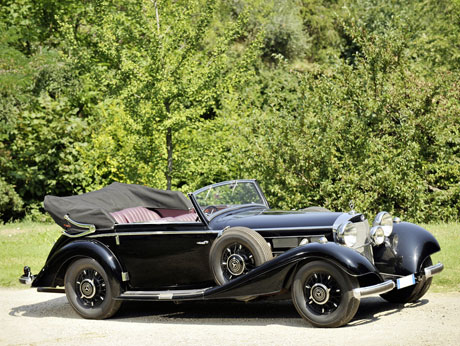SCM Analysis
Detailing
| Vehicle: | 1937 Mercedes-Benz 540K |
| Number Produced: | 400 approx. |
| Original List Price: | $7,500 |
| Tune Up Cost: | $5,000 |
| Chassis Number Location: | Left frame rail |
| Engine Number Location: | Right side of engine block |
| Club Info: | Mercedes-Benz Club of America 1907 Lelaray St. Colorado Springs, CO 80909 |
| Website: | http://www.mbusa.com/classiccenter |
| Alternatives: | 1932 Horch 670 V12 cabriolet, 1930 Hispano-Suiza H6B, 1938 Maybach SW38 |
| Investment Grade: | A |
This 1937 Mercedes-Benz 540K Cabriolet C sold for $519,318, including buyer’s premium, at the Bonhams auction in Reims, France, on September 26, 2009.
With about 400 540Ks built, they represent the pinnacle of Mercedes-Benz’s pre-war achievements. There are a number of body variations, which affect values significantly, so here’s a short history lesson.
Most valuable are Special roadsters, and the Holy Grail is the so-called long-tail, high-door model, of which only about 25 were made. Of those, only about five had the very desirable covered spare. These were some of the finest looking cars ever made, with a massive V-shaped radiator set behind the front axle line, front fenders over eleven feet long, and a completely disappearing soft top. If one of these were to come on the market today, it would command over $10m.
Next are the “not so special” roadsters, such as the low-door model and the bulbous rumble seat model. These, depending on condition and history, take a huge hit compared to the long-tail. They’re in the $2m-$3m range. Again, it’s the exact same car under the skin, so it shows you how much style and perception play in the values. It’s like comparing a Ferrari GTO to a Lusso.
From there we go to the Sport cabriolet A. Some of these were custom-designed one-offs. Those that feature the laid-back V-shaped windshields are the best looking cab As. It should be mentioned here that 540 aficionados prefer the Mercedes Sindelfingen-built cars to the outside custom bodywork. As would most auto makers, Mercedes would sell you a rolling chassis, which you could then take to the coachbuilder of your choice. But, oddly enough, they aren’t as popular as the factory-built cars. These cost a shade under $2m.
Maybe not sexy but definitely imposing
Next in line is the standard cab A, a pedestrian but very well built two-seater. Mercedes built around twelve of these with the more attractive 500K bodywork with rear spares, and these bring the most money, probably over $1.5m, leaving the standard cab A at $1m-plus.
Following these we have the four-seat versions-the cab B and cab C. The cab B is a two-door with four side windows. The cab C, which is our subject car here, has two doors, two side windows, and a Victoria-style top that covers the area where the quarter windows would be. These are a toss-up for desirability, as there are friends in both camps. I prefer the cab B, as it looks lighter above the belt line due to all the glass. These can bring around $1m.
The 1937 540K Cabriolet C we have here sold in Reims, and although I did not see it personally, it is a matching-numbers example and looks very well done in the photos. It’s finished in the highly desirable black with red combination. Mercedes of the period look best in dark single colors; they don’t take well to light or bright shades.
At the sale, SCM auction reporter Jérôme Hardy wrote: “Restored to show standards some years ago I would guess, but still sharp in and out. Nothing to fault on this icon, which dates from when Germany was showing the world that they were building the very best. Veneer amazing, deep wool carpets, panel fit perfect. Matching numbers, history clear, no stories, and in its original color combination. Maybe not sexy, but imposing. Smartly bought 15% below the low estimate of $588,000. (Compare with a 1937 540 cabriolet A, SCM #48023, sold at RM London for $1.4m in October 2007.) Still, it might have done better at Rétromobile in a few months in front of a more international crowd. Good news for the buyer. I would consider this a bargain.”
So this 540K Cabriolet C was bought below the low estimate and was a bargain for the buyer. Bravo. It does, however, bring out one of the hidden faults in the auction system. It may well have done better at Rétromobile, and this just goes to show that you have to do your homework and pick the right auction and venue for your particular car.
Auctions can bring world record prices, or they can brand a car that does not do well. Like everything in life, legwork you do beforehand will pay off in the end. The low price this car achieved puzzles me. Maybe it took a little punch in the nose for being right-hand drive, but this seems like an awful lot of car for the money. Perhaps the market has shifted more than I am aware of, but all things considered, I’d simply call it very well bought.
